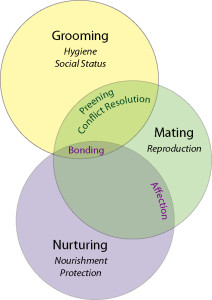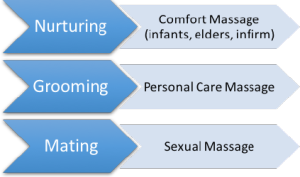 Often overlooked in the ongoing quest for a coherent identity for the massage profession are its evolutionary roots. In other words, what is the genetic basis for what we now call massage?
Often overlooked in the ongoing quest for a coherent identity for the massage profession are its evolutionary roots. In other words, what is the genetic basis for what we now call massage?
In the animal kingdom the general impulse to touch one another is termed social touch and is not only clearly evident in our primate ancestors but has also been identified in insects, birds, bats and virtually all mammals. That means that social touch has been hard wired into our genomic heritage for over 200 million years. What part of social touch gave rise to massage?
In primates, social touch can be divided into three overlapping functional categories: nurturing, grooming, and mating.
- Nurturing touch originated from the need of infant mammals to be fed and protected.
- Social grooming evolved for hygienic reasons, the need to keep the hair, fur, feathers and other skin coverings clean and free of leaves, twigs, insects, parasites and other objects.
- The reproductive/mating instinct is fundamental to all animals for propagation of their species.

Other overlapping functions of the varieties of social touch are also important. All three are examples of bonding behavior in its broadest sense of the word. Not only does touch tie parents to their offspring, mates to each other and individuals to the family or tribe, but touch has two other deep existential functions that often get overlooked. Touch creates a subjective sensation in recipients that validates their unique individuality (bonding to myself) while, at the same time, it provides a “reality check” of their objective presence in and connection to the exterior environment. In an era of increasingly virtual relationships both of these benefits take on a new significance.
Grooming and nurturing kinds of touch overlap with mating touch in the forms of preening and affection, as noted in the illustration. Grooming and mating touch in some species, such as hominids, are also overlap when they are used for conflict resolution or reconciliation.
Wither professional massage?
 All massage done today by trained practitioners can trace its roots to at least one of these instinctual categories touching.
All massage done today by trained practitioners can trace its roots to at least one of these instinctual categories touching.
While every massage can be said to have a nurturing component (as described above in the discussion of bonding), nurturing touch is specifically the progenitor for what could be called comfort massage. These massage practitioners either provide massage services or massage training for populations such as the very young, the very old and the infirm. Examples include infant massage, geriatric massage and hospice massage.
Next, the grooming instinct has birthed the largest category of professional massage services: the personal care massage.
Parents or other family members are the primary groomers of their infants and children. They attend to the hygiene of their hair, nails, ears, nose, eyes and, most importantly, of their skin. They bathe and anoint their young with oils, lotions, and powders and, in this interaction, give them their first experience of the benefits of interpersonal touch.
As our children get older and more independent they begin to assume many of these grooming responsibilities for themselves. But society has also developed a whole economic sphere that can perform these functions called personal care services and its occupational categories include:
- Hair stylists
- Manicurists
- Skin Care Specialists
- Makeup artists
- Massage practitioners
Most professional massage being provided today is personal care massage and it is easy to argue that it is more necessary than ever. With the emergence of higher levels of consciousness and more complex social systems, humans have the dubious distinction of being the only primate that can choose to override its natural instincts and live without interpersonal touch. Indeed, in many contemporary cultures, touching is now demonized, restricted or outright prohibited. Most people walk around today with a touch deficit. Personal care massage is one of the few ways that this primal need for touch can be safely met.
Finally, professional sexual massage services are a clear outgrowth of the mating touch instinct and, where they are not illegal, these days are often euphemistically described as “adult” or “tantric” massage.
Implications for our professional identity
Health care massage is the label that most massage schools, associations prefer for massage services. However, using touch techniques to ameliorate pain or injuries is actually a second order of massage services once removed from instinctual nurturing or grooming touch. It could be argued that the genetic roots of health care massage are in self-touch, i.e. rubbing my sore spot to make it feel better. It wasn’t until some primates (and most particularly human primates) developed a capacity for empathy (feeling the pain of another) that interpersonal touch for relief became conceivable, i.e. rubbing your sore spot to make it feel better.
That’s not to say that health care or wellness massage can’t have the same benefits of comfort and personal care massage. It can and often does. However, it is the difference between eating chicken soup because you are hungry and eating (or feeding someone) chicken soup to cure what ails you. The former is instinctual and the latter requires a higher level of intention.
That distinction is important and often overlooked. The best use of massage is not to act as an ambulance at the bottom of a cliff (health care treatment), but rather to be the guard rail at the top of the cliff (health maintenance). Conflating (personal care) “massage” with (health care) “massage therapy” over the past 30 years has, unfortunately, resulted in the wide spread impression that massage is only useful when something has gone wrong. If we want to have a coherent identity for professional massage, it will have to include, but make a distinction between, both massage and massage therapy.
If you have any comments or thoughts about the genetic roots of our profession, please share them below.




As always, David, your article is both well thought out and thought provoking!
simple and therefor genius
the very basics of every core-energy work to give the “customer” a expirience of being not seperated from anything ^^)
my words miss for shure, so i better start “touching” (^^ as i cant edit my further message:
thank you, david
This is really awesome information, so important yet not enough emphasis is made to it in general. Keep up the great work David